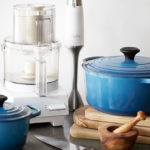




A Perfect Summer Soup
Since our move from Los Angeles to the San Francisco Bay Area set into motion, a vacuum of preoccupation – involving hospitals, old projects, partnerships, insurance claims, a lifetime of archives, my parents selling their home, my husband starting grad school and the move itself, enveloped me whole as I dealt with the past and moved towards renewal. I’ve felt guilt ridden for disappearing these last couple months, but as you can surmise from this partial list of life events, I’ve had good reason.
Not surprisingly two days after the solar eclipse, I feel like much of the weight has lifted and time has finally released me back into the present moment. Free to create something new, rather than peeling away the past, purging, finishing and tidying things up. If I’ve ever felt the effects of an eclipse, this has been it.
And this Chłodnik recipe (pronounced h-wo-d-neek, meaning cooler) is the perfect dish to usher in a new beginning. It’s one of my favorite Polish dishes, and one that reminds me of my grandmothers as well as my native roots, yet food has the capacity to give us a taste of the familiar and allow us to linger for a moment in memory, while gently releasing us once the meal is gone.
Chlodnik is very much my petites madeleine. A dish that brings me exquisite pleasure – not just because of its vibrant beauty and deliciously rich flavor, but because it carries with it the spirit of life itself. Metaphorically for me, and nutritionally in being a live, probiotic food full of minerals and precious nutrients.
Let’s not forget to highlight just how delicious this summer soup is! Even if you have no connection to the Polish culinary tradition, you will enjoy it through and through. Served cold, it’s tart and tangy, with a hint of earthy sweetness from the beets, contrasted by sharpness imbued by the addition of radishes, dill and parsley. Cucumbers and kefir make it especially refreshing in it’s chilled state. Hard boiled eggs and crème fraîche round it out.
Cooking Notes
As impressive as this soup can be, especially when served with artfully arranged garnishes, it requires surprisingly little work and time to make. This makes it perfect for a casual, light dinner for family or to serve as a first course for guests.
Because the soup is in a lacto-fremented kefir or buttermilk base, it keeps well for over a week or more as the live pro-biotic bacteria feed on the sugary starches in the veggies. This also makes it great summer lunch fare, since it will keep well between packing it in the morning and your lunch hour.
Kefir or Buttermilk
If you can get your hands on real raw fermented whole-fat buttermilk, that would be my number one recommendation. In California you should look for Organic Pastures new Whole Milk Kefir, this is technically a raw buttermilk.
You won’t have access to real buttermilk in many areas, in that case I’d recommend going with a pro-biotic kefir. It’s not easy these days to find whole milk yogurts or kefir these days either, which is how I ended up with the yummy Green Valley Organics lactose-free kefir in my photo above. Although I wasn’t looking for a lactose free kefir, it was the only whole milk grass-fed option and was very good – creamy yet crisply tart.
Whatever you do, don’t skimp on the fat. You’ll get the most health benefits from full-fat pasture raised dairy and the best taste with either whole milk kefir or real buttermilk. If you have access to raw milk, just make your own buttermilk!
Yogurt
You don’t really need to add yogurt to the mixture, but most traditional recipes include both kefir and yogurt. It gives the soup a little extra thickness. Again, go for the real stuff: whole milk and cream top yogurt made from milk that comes from pasture raised cows. Maple Hill is available at many Whole Foods and theirs is one of the best plain, whole milk yogurts (when not buying from a small scale local producer).
Crème Fraîche
If crème fraîche is not available to you, use your favorite sour cream. Sour cream is traditionally a lacto-fermented food, which has a much different flavor and texture than the chalky, mouth-puckering stuff you get when buying conventional American sour cream.
By contrast, most crème fraîche brands that I’ve seen in the U.S. produce a live, cultured creme, and have the creamy texture and lightly sweet tartness that real sour cream should have. In California, Sierra Nevada Cheese makes a delicious crème fraîche that comes from pasture raised cows.
Pickle Juice
Be sure to use juice from real lacto-fermented pickles. If you’re not in the habit of making your own, you’ll find live, fermented pickles in the refrigerated section at your grocer. If you plan to make this recipe a few days out, you can make your own pickles in just 3-5 days fermentation time!
It’s the easiest probiotic food to make at home and if you make a big batch it can last for months in your fridge. Here’s how to make your own pickles to yield as much pickle juice as you need:
OLD FASHIONED LACTO-FERMENTED PICKLES
Beets
You can prepare these in a couple different ways. The simplest is just to boil the beets whole, complete with skins after giving them a good scrub and rinse. Once cooled slip off the skins with your hands.
If you want to make the soup even more nutritious and rich in flavor, peel and quarter the beets before cooking. Use bone broth to boil the beets for about 12 minutes and add roughly a cup of the broth to your Chłodnik.
In either case reserve, the beet broth and use it in another recipe, or drink it with a splash of apple cider vinegar for a delicious health tonic.




